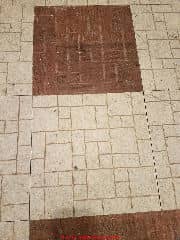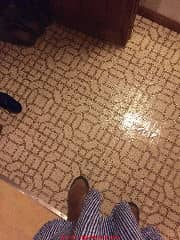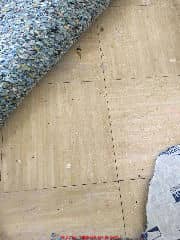 Asbestos-Containing Floor Tiles & Sheet ID 1974-1979
FAQs
Asbestos-Containing Floor Tiles & Sheet ID 1974-1979
FAQs
Photos & Q&A on identifying asbestos-suspect flooring from the 1970s
- POST a QUESTION or COMMENT about how to identify brands & types of vinyl & vinyl-asbestos floor tiles & sheet flooring & about the asbestos content of these products
Photo guide to asphalt asbestos and vinyl asbestos floor tiles, 1974-1979:
This article provides a guide to identifying asphalt-asbestos flooring & vinyl asbestos floor tile sold & installed in North American from 1974-1979.
We provide identification photographs, product names, styles, colors, and vinyl-asbestos floor patterns, and colors for asbestos-containing floor tile products made between those years (and link to information on other years) to help identify flooring materials that are reported to or have been confirmed to contain asbestos in asbestos fiber or asbestos powder-filler form.
InspectAPedia tolerates no conflicts of interest. We have no relationship with advertisers, products, or services discussed at this website.
- Daniel Friedman, Publisher/Editor/Author - See WHO ARE WE?
Armstrong Floor Tile Identification Guide - 1974 - 1979
 These questions and answers about identifying floor tiles or sheet flooring made between 1974 and 1979 were originally posted at ASBESTOS FLOOR TILE IDENTIFICATION PHOTOS 1974-1979 - be sure to see the photo ID guide to Armstrong and other flooring given there.
These questions and answers about identifying floor tiles or sheet flooring made between 1974 and 1979 were originally posted at ASBESTOS FLOOR TILE IDENTIFICATION PHOTOS 1974-1979 - be sure to see the photo ID guide to Armstrong and other flooring given there.
On 2019-01-20 by (mod) - I suspect these 9x9 floor tiles from 1978-79 contain asbestos
I can't seem to post a comment for the ID guide articles. 1978/1979 built housing, landlord doesn't know about the dating for flooring in the entryway. One the tiles has a chunk missing from it, and it's been exposed all year to our family foot traffic.
i am hoping to convince landlord to cover and seal it because I suspect it's 9x9 asbestos tile.
It looks to be cream or yellow colored, has a pattern like some of the Armstrong stuff. Does it look familiar to you?
The shiny bit in the center is where I just put down packing tape over it so no more chunks might flake off while my landlord responds to me.
Maybe that was stupid to do, but seemed better than having it totally exposed like it was. -E. Anonymous by private email 2019/01/20
Moderator reply: these 5 questions help you figure out if a floor tile or sheet flooring contain asbestos
E, your floor tile looks much like other Armstrong VAT (Vinyl Asbestos Tile) products that contained asbestos and that date from the late 1970's or early 1980's.
Please take a look at
ASBESTOS FLOORING IDENTIFICATION
where I pose 5 questions that can help make a reasonable guess at whether or not a specific flooring product contains asbestos before a lab test.
Please take a look there and let me know what else you can say about your floor and/or what further questions you have.
On 2018-08-06 by (mod) - asbestos risk in flooring up to 1985
If the home and floor date from before the mid 1980's it would be prudent to treat the floor in your photos as presumed to contain asbestos - or to have a sample tested.
On 2018-08-06 by Anthony M
Hi I have some tiles in my house that i want to remove. My house is older but I am not sure when the tile was installed. I want to say they could have been installed anytime later.By the look at these could you help
On 2018-06-23 by (mod) - advice if you have to remove asbestos-suspect flooring
Jessie
With the obvious apology that I can't bet your health on a building I can't see and about which I know nothing, in general, if you follow
the ASBESTOS REMOVAL, WETTING GUIDE
recommended by various authorities you are doing the job correctly.
Keep in mind that some floor tile adhesives or mastics also contain asbestos and may need cautious treatment too. Some can dissolve in water (some of the latex-based adhesives used in the 70's and later) while asphalt based mastics do not dissolve in much besides organic solvents but also are not so easily airborne.
On 2018-06-23 by Jessie
Thank you for your quick response. We will definitely treat it as asbestos. I read those articles. We tried to keep it but unfortunately we can’t.
Because it’s vinyl tile flooring do you think adequately wetting it would be good enough? We’re not removing tile by tile just sawing 3’x3’ sections with the plywood attached to it.
On 2018-06-23 by (mod) - how to manage the asbestos floor hazard
Jessie,
The age of building and of flooring, as well as country location as well as flooring type and pattern all figure into a guess about whether or not it is likely to contain asbestos. For floors made or installed in North America before 1986 it would be prudent to treat the floor as presumed to contain asbestos. So if your floor dates from the 1960's it's likely to contain asbestos.
Intact, un-disturbed by sanding, grindking, sawing, chopping, etc., asbestos-containing asphalt or vinyl tile or sheet flooring is not friable -it does not readily release detectable levels of harmful asbestos into the air of the building where it is installed.
When possible the safest, least expensive, and most-recommended approach is to leave the floor alone, in place, and to seal or cover it over with a new layer of material. However some circumstances including a floor in poor condition or some building renovation work might justify floor removal.
See ASBESTOS REMOVAL, WETTING GUIDE https://inspectapedia.com/hazmat/Asbestos_Wetting_Procedure.php
and
for a more complete picture of what to do see
ASBESTOS FLOORING HAZARD REDUCTION https://inspectapedia.com/hazmat/Asbestos-Hazard-Reduction.php
and ASBESTOS FLOORING REMOVAL GUIDE https://inspectapedia.com/hazmat/Asbestos-Floor-Removal.php
On 2018-06-23 15:38:59.572506 by Jessie
We are wetting the tile floor before cutting it with a saw, would that be okay?
On 2018-06-23 15:37:11.709812 by Jessie
My 2nd question As a follow up to the picture asking if it’s asbestos flooring would be.
I’m having wood floors installed and the vinyl floor along with the plywood that it’s attached to has to be removed. We will be cutting 3’x3’ sections of the tile with the plywood without detaching the tile from the plywood. Since we are cutting the tile
I have this type of floor in my dining room and I’m worried it might be asbestos.
I know it’s a house built in 1962 but I think they may have added this floor later. Can you tell me if it could be asbestos?
On 2018-06-22 by (mod) -
Looks like cork style vinyl asbestos floor tile.
On 2018-06-22 by MJ
We recently had flooding in our basement and found tile under our carpeting. We have only lived here a short time and weren't expecting it.
The neightboor who knew the old owners believed the put it in the mid 70s.
I can't seem to find it in the guide but it has several indications being 9x9 and having black mastic. Thoughts on what it may be?
On 2017-05-07 12:54:05.134194 by (mod) -
It's possible that your flooring contains asbestos and it's prudent to treat it as presumed to do so. If you remove intact tiles for replacement there is close to zero chance of a measurable asbestos hazard. Avoid grinding, sawing, chopping or making a dusty mess.
On 2017-05-07 01:53:39.162387 by BG Goldberg
Just bought a house built in 1972. The garage floor is covered with Britefloor 12"x12" stick on tiles. Any idea if these contain asbestos ? Some are broken
And I was going to pull a few up and put down some new ones. Good or bad idea?
On 2017-03-20 by (mod) -
Jeanette
Indeed I'd beware that the "glue" used could have been an asbestos-containing black or tan mastic adhesive.
HEPA vacuuming, if the vacuum wasn't leaky, was a component of a good approach.
You'd need to test a sample (Search InspectApedia for ASBESTOS TESTING LAB LIST to find a certified lab) or perhaps to test settled dust in your home to see in more cleaning is needed.
On 2017-03-20 by Jeanette
Our brick ranch home in the Louisville,KY area was built in 1974. Up until now we have had the original kitchen vinyl flooring that was never removed. We are now doing a remodel and we started taking up several layers of floor by our back door in the kitchen down to the sub floor.
The 2 upper layers were floors that we layedatop the original vinyl throughout the late 1980's until the present time. Now we are laying solid hardwood and my husband wanted to get all of the layers of old flooring up so our back door wouldn't have to be cut on the bottom to accommodate the thicker hardwood.
The original floor was glued to the subfloor and he started pulling that up with a hammer and crowbar.
That floor was vinyl sheet flooring with a gold square pattern running through it. Suddenly I had him stop tearing it up when I considered the possibility it may contain asbestos. He the picked up and bagged the pieces of vinyl he scraped up and used a shop vac with a hepa filter to clean the debris.
What is the possibility that what was pulled up may contain asbestos and what is our next step? I have lung problems already and am stressing out over this. About a 3'x 4' area was involved in this.
On 2016-08-19 by (mod) -
IF you can remove old floor tile intact, without cutting, grinding, sanding, making a dusty mess, the airborne dust level from the flooring itself should be close to zip.
On 2016-08-19 by Lori
We purchased a home built in 1975. Both full upsairs bathrooms have what appear to be 12" x 12" peel and stick tile, white with gold running throughout. The tile in one bathroom is beginning to buckle. Do I need to call someone in yo remove or can I do it myself?
On 2016-01-30 by Dulcy
I just bought a home built in the mid 70s. We just found water coming up out of the tiles. We started tearing them up without thought of asbestos. I'm worrying a bit since I have two kids. I couldn't locate any tiles that matched and didn't know if you could identify them? There are three tile types in the basement
On 2015-10-17 by jordan
I believe the following description is an erroneous identification for the first photo in the above section captioned "1974 - Complete Armstrong Excelon Vinyl Asbestos Floor Tiles, Patterns & Color Guide":
"Our photo left is probably Glenmore Brick 12" x 12" x 1/16" (White, 57131) found in a home in Poughkeepsie, NY."
That pattern of adjacent pairs of horizontal and vertical "bricks" (and their interior "texture") appears to be identical to the kitchen flooring I am now looking at in the kitchen of my (unfortunately) recently passed parents.
My mom kept great records and I have the original February 1975 agreement, Armstrong warranty, and invoice for installing (over "existing vinyl") the following which I believe correctly identifies the first photo on this page:
"Stock #DO 8093, Manufacturer Armstrong Designer, Pattern Solarian, Color # 89282, total $496.88 for "vinyl and labor"; "3 gold flat" and "9' gold".
In the process of googling for kitchen floor cleaning info I just discovered the "asbestos" issue. Great news. I found elsewhere that the asbestos was banned in 1972 and, if so, wonder why Armstrong in 1975 sold asbestos flooring.
Thanks much for this wonderful site (more later about its usefulness). Anyway, hope this info might help.
If you do not know the brand name of your flooring you can take a quick look at example photos of the product line of each manufacturer given at ASBESTOS FLOORING IDENTIFICATION GUIDE INDEX - all brands, all years .
...
Continue reading at ASBESTOS FLOOR TILE IDENTIFICATION PHOTOS 1974-1979 or select a topic from the closely-related articles below, or see the complete ARTICLE INDEX.
Or see these
Recommended Articles
- ASBESTOS FLOOR TILE PHOTO ID GUIDE - home
- ASBESTOS FLOOR TILE IDENTIFICATION COLOR KEY - home
- ASBESTOS FLOORING HAZARD REDUCTION
- ASBESTOS FLOORING IDENTIFICATION
- ASBESTOS FLOORING IDENTIFICATION GUIDE INDEX - all brands, all years
- ASBESTOS FLOORING REMOVAL GUIDE
- ASBESTOS REMOVAL, WETTING GUIDELINES
- ASBESTOS RISK ASSESSMENT
- ASBESTOS TEST RESULTS for TILE & SHEET FLOORING
- ASBESTOS TESTING LAB LIST
- DOES THIS FLOOR CONTAIN ASBESTOS? - 5 easy questions to tell if your FLOOR probably contains asbestos -
- DOES THIS MATERIAL CONTAIN ASBESTOS? - 5 easy questions to tell if a BUILDING MATERIAL probably contains asbestos -
- MARBLE / STONE CHIP PATTERN FLOORING ASBESTOS
- RESILIENT SHEET FLOORING ID GUIDE
Suggested citation for this web page
ASBESTOS FLOOR TILE IDENTIFICATION PHOTOS 1974-1979 FAQs at InspectApedia.com - online encyclopedia of building & environmental inspection, testing, diagnosis, repair, & problem prevention advice.
Or see this
INDEX to RELATED ARTICLES: ARTICLE INDEX to ASBESTOS HAZARDS
Or use the SEARCH BOX found below to Ask a Question or Search InspectApedia
Ask a Question or Search InspectApedia
Try the search box just below, or if you prefer, post a question or comment in the Comments box below and we will respond promptly.
Search the InspectApedia website
Note: appearance of your Comment below may be delayed: if your comment contains an image, photograph, web link, or text that looks to the software as if it might be a web link, your posting will appear after it has been approved by a moderator. Apologies for the delay.
Only one image can be added per comment but you can post as many comments, and therefore images, as you like.
You will not receive a notification when a response to your question has been posted.
Please bookmark this page to make it easy for you to check back for our response.
IF above you see "Comment Form is loading comments..." then COMMENT BOX - countable.ca / bawkbox.com IS NOT WORKING.
In any case you are welcome to send an email directly to us at InspectApedia.com at editor@inspectApedia.com
We'll reply to you directly. Please help us help you by noting, in your email, the URL of the InspectApedia page where you wanted to comment.
Citations & References
In addition to any citations in the article above, a full list is available on request.
- In addition to citations & references found in this article, see the research citations given at the end of the related articles found at our suggested
CONTINUE READING or RECOMMENDED ARTICLES.
- Carson, Dunlop & Associates Ltd., 120 Carlton Street Suite 407, Toronto ON M5A 4K2. Tel: (416) 964-9415 1-800-268-7070 Email: info@carsondunlop.com. Alan Carson is a past president of ASHI, the American Society of Home Inspectors.
Thanks to Alan Carson and Bob Dunlop, for permission for InspectAPedia to use text excerpts from The HOME REFERENCE BOOK - the Encyclopedia of Homes and to use illustrations from The ILLUSTRATED HOME .
Carson Dunlop Associates provides extensive home inspection education and report writing material. In gratitude we provide links to tsome Carson Dunlop Associates products and services.



